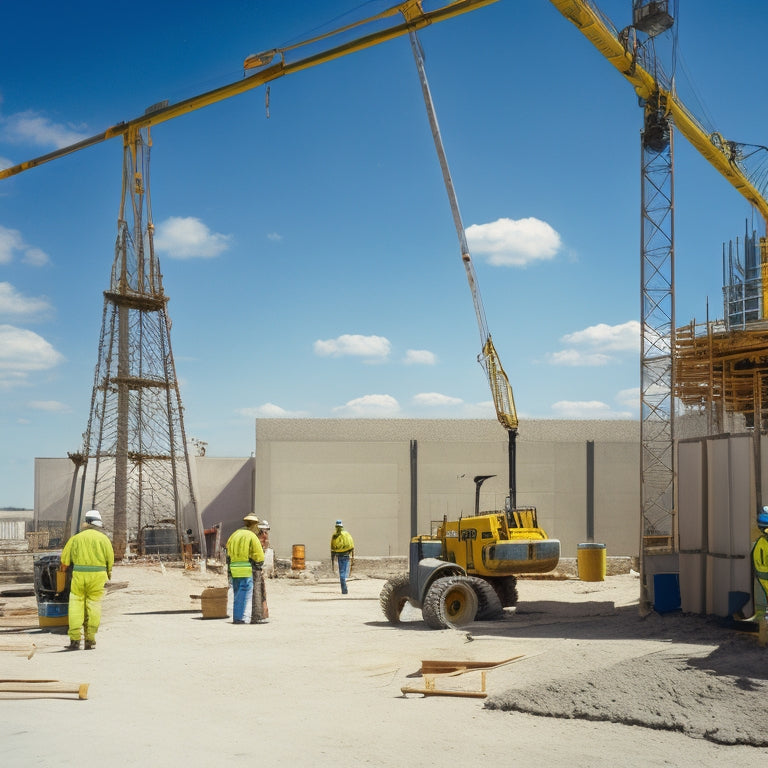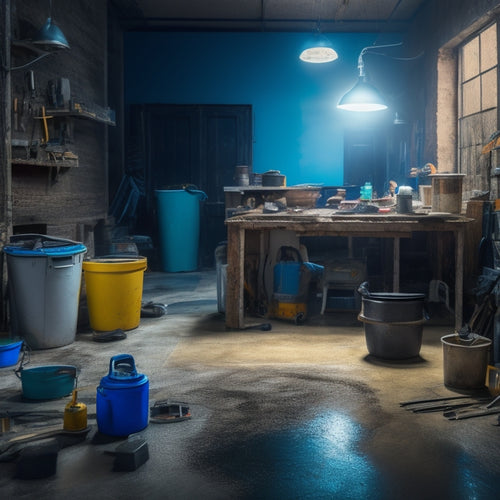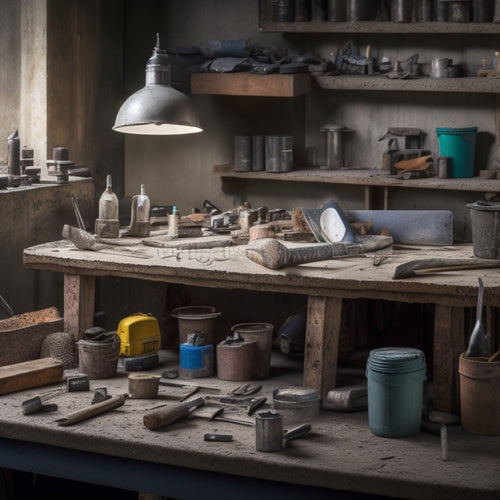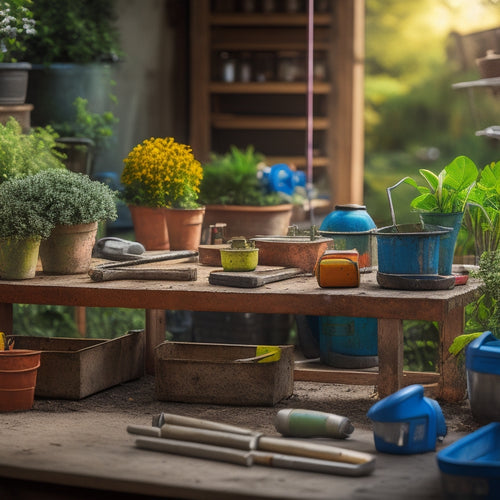
10 Best Tools for Building Concrete Walls
Share
When building a concrete wall, you'll need a range of specialized tools to guarantee a strong, durable, and visually appealing structure. From essential mixing equipment like sturdy mixers and batching tools, to cutting tools such as concrete saws and blades, every tool plays a critical role. You'll also need hammer and chisel sets, measuring and marking tools, and concrete finishing and smoothing tools like trowels and floats. Don't forget drill bits for anchoring, leveling and alignment tools, vibrating and compacting equipment, and edging and jointing accessories. With the right tools, you'll be well on your way to building a top-quality concrete wall; now, get familiar with each tool's specific role in the process.
Key Takeaways
• A sturdy mixer is vital for achieving proper consistency and strength in concrete mixes, ensuring optimal mixing ratios.
• Cutting tools, such as concrete saws and blades, require regular maintenance for precise cuts and efficient concrete wall projects.
• Hammer and chisel tools, including point, flat, and claw chisels, offer versatility and control during concrete wall construction.
• Measuring and marking tools, like tape measures, levels, and marking paint, ensure accurate planning and execution of concrete wall projects.
• Safety gear, including hard hats, safety glasses, and steel-toed boots, is essential for protecting workers from hazards during concrete wall building.
Essential Concrete Mixing Equipment
Mixing concrete to the right consistency and strength requires having the vital concrete mixing equipment, including a sturdy mixer, reliable batching tools, and accurate measuring devices.
As you prepare to build your concrete wall, you'll need to verify your equipment is in top condition. Regular equipment maintenance is key to achieving the perfect mixing ratios. You'll want to check your mixer's blades for wear and tear, and clean or replace them as needed. Additionally, calibrate your measuring devices to guarantee accurate proportions of cement, sand, and water.
You'll also need to take into account the type of mixer you're using. A planetary mixer, for instance, is ideal for mixing small batches, while a horizontal shaft mixer is better suited for larger quantities.
Regardless of the mixer type, it's important to follow the manufacturer's guidelines for mixing ratios and procedures. By having the right equipment and maintaining it properly, you'll be able to achieve a consistent and strong concrete mix, which is vital for building a durable and long-lasting concrete wall.
Power Tools for Efficient Cutting
When you're building concrete walls, you'll need power tools that can efficiently cut through the concrete.
You'll want to choose tools that can make precise cuts, reducing waste and saving you time.
To achieve this, you'll need to select the right saw blades and understand how to use them effectively for different types of cuts.
Cutting Concrete Efficiently
You'll need a reliable concrete saw or demolition saw to cut through concrete efficiently, as these power tools are specifically designed to handle the hard, abrasive nature of concrete.
When it comes to cutting concrete efficiently, mastering the right cutting techniques is vital. This involves maintaining a consistent pace, applying steady pressure, and using the correct blade angle.
Additionally, proper blade maintenance is important to guarantee peak performance and extend the lifespan of your saw. Regularly inspect your blade for signs of wear, such as cracks or excessive wear on the teeth, and replace it as needed.
Clean your blade regularly to prevent debris buildup, which can affect its performance.
Saw Blades for Walls
By selecting the right saw blade for your concrete wall project, you can greatly boost your cutting efficiency and accuracy.
When it comes to saw blades for walls, you have several options to choose from, including diamond blade types. Diamond blades are designed for high-performance cutting and are ideal for concrete wall construction.
For instance, segmented diamond blades are suitable for rough cutting and demolition work, while continuous rim diamond blades are better suited for precision cutting and finishing. You can also opt for turbo diamond blades, which offer a balance between speed and precision.
When choosing a saw blade, consider the wall cutting techniques you'll be using. For example, if you're using a walk-behind saw, you'll need a blade designed for that specific application.
Additionally, consider the size and type of concrete you're working with, as well as the power and speed of your saw. By selecting the right saw blade, you can optimize your cutting process, reduce downtime, and improve the overall quality of your concrete wall construction project.
Hammer and Chisel Set Essentials
A thorough hammer and chisel set is a fundamental component of any concrete wall building project, providing the necessary tools to break, shape, and refine the concrete.
You'll need a variety of chisel types to tackle different tasks. For instance, a point chisel is ideal for breaking up concrete, while a flat chisel is better suited for shaping and smoothing out surfaces. A claw chisel, on the other hand, is perfect for removing small amounts of concrete or debris.
When it comes to hammers, the material you choose can make a significant difference. Steel hammers are durable and provide a high-impact force, making them ideal for breaking up thick concrete. However, they can be heavy and may cause fatigue.
Fiberglass or graphite hammers, on the other hand, are lighter and provide a more controlled force, making them suitable for more precise work. Regardless of the material, look for a hammer with a comfortable grip and balanced weight distribution to reduce fatigue and improve accuracy.
With the right hammer and chisel set, you'll be well-equipped to tackle any concrete wall building project.
Measuring and Marking Tools
Accurate measurements and markings are essential to the success of your concrete wall building project, so it's important to have a reliable set of measuring and marking tools at your disposal. You'll need tools that can provide precise readings and withstand the demands of a construction site.
Here are the necessary measuring and marking tools you'll need:
-
Tape measure: A 25-foot or 30-foot tape measure is ideal for measuring concrete walls. Mastering tape measure techniques, such as using the 'hook' to measure from corners, will save you time and effort.
-
Level: A level guarantees your walls are straight and plumb. Look for a level with a magnetic edge that can stick to metal studs or a rotating vial for precise readings.
-
Marking paint: Marking paint applications are critical for marking layouts, such as wall dimensions, door and window openings, and anchor bolt locations. Choose a paint that's specifically designed for concrete and can withstand weather conditions.
- Chalk line: A chalk line helps you create straight lines on your concrete walls. It's especially useful for laying out block courses or creating a level line for finishing.
With these measuring and marking tools, you'll be able to accurately plan and execute your concrete wall building project.
Concrete Finishing and Smoothing
As you move on to the concrete finishing and smoothing stage, you'll need to master various techniques to achieve a smooth, even surface.
You'll want to understand the different finishing methods, such as tamping, floating, and troweling, to produce the desired finish.
To execute these techniques effectively, you'll require a set of specialized tools designed for concrete smoothing and finishing.
Finishing Techniques Explained
You'll need to master various finishing techniques to achieve a smooth, even surface on your concrete walls. This involves understanding the different trowel techniques and surface textures that can be achieved. The right finishing technique can make a significant difference in the appearance and durability of your concrete walls.
Here are four essential finishing techniques to take into account:
-
Float finishing: Uses a float tool to create a smooth, even surface with minimal texture.
-
Trowel finishing: Employs a trowel to apply pressure and create a dense, smooth surface with a slight sheen.
-
Broom finishing: Involves dragging a broom across the surface to create a textured, slip-resistant finish.
- Stamp finishing: Uses specialized tools to create intricate patterns and designs on the surface of the concrete.
Smoothing Tools Required
After mastering the finishing techniques, focus on selecting the right smoothing tools to refine your concrete wall's surface.
You'll need a range of tools to achieve a smooth, even finish. Start with a bull float, which helps to remove excess water and flatten the surface. Next, use a darby to further flatten and smooth the concrete. For more precise control, switch to a trowel, which allows you to target specific areas and achieve a high-gloss finish.
When it comes to surface preparation, make sure to remove any excess material or debris that may interfere with the smoothing process. Use a wire brush or broom to remove any loose particles, and then apply a release agent to prevent the smoothing tools from sticking to the concrete.
Safety Gear for Wall Building
Wearing the right safety gear is essential when building concrete walls, and you must have at least six important items to guarantee your protection. You're working with heavy materials, power tools, and potentially hazardous substances, so it's imperative to prioritize your safety protocols.
Here are the must-haves for your safety gear checklist:
-
Hard hat: Protect your head from falling objects, debris, and accidental tool drops.
-
Safety glasses: Shield your eyes from concrete dust, flying particles, and chemical splashes.
-
Steel-toed boots: Guard your feet from heavy object impacts and crushing injuries.
- Dust mask: Filter out airborne particles and prevent respiratory problems.
Don't compromise on your protective clothing, either. Wear long-sleeved shirts, long pants, and gloves to prevent skin irritation and abrasions.
Drill Bits for Anchoring
When building concrete walls, you'll need to anchor your walls securely, and that starts with the right drill bits.
You'll want to take into account the anchor hole size, as it needs to match the anchor type and wall thickness.
Anchor Hole Size
You'll need to drill holes of a specific size to accommodate the anchors that will secure your concrete wall to the foundation or other structural elements. The anchor hole size is critical, as it affects the anchor's holding power and the structural integrity of your wall.
Here are some key considerations for anchor hole size:
-
Anchor depth considerations: The anchor hole should be deep enough to allow the anchor to penetrate the concrete to the recommended depth, typically 1-2 inches.
-
Anchor spacing guidelines: The hole spacing should be consistent with the manufacturer's recommendations, usually 12-24 inches on center.
-
Anchor type and size: The hole size will depend on the type and size of anchor you're using, such as a 1/4 inch or 1/2 inch anchor.
- Concrete thickness: The hole size may need to be adjusted based on the thickness of your concrete wall, ensuring the anchor can penetrate the concrete fully.
Drill Bit Quality
Drill Bit Quality (Drill Bits for Anchoring)
Selecting high-quality drill bits specifically designed for anchoring is essential to confirm accurate hole placement and prevent damage to the concrete or anchors during the drilling process. You'll want to reflect on the type and material of your drill bits to make certain they can handle the demands of concrete drilling.
When choosing a drill bit, you'll encounter various materials, including carbide-tipped, diamond-coated, and solid carbide. Each has its strengths and weaknesses, which are summarized in the table below:
| Drill Bit Material | Advantages | Disadvantages |
|---|---|---|
| Carbide-Tipped | Cost-effective, suitable for small projects | May wear out quickly, prone to breakage |
| Diamond-Coated | Fast drilling, long lifespan | Expensive, may overheat |
| Solid Carbide | Extremely durable, high-speed drilling | Very expensive, requires specialized equipment |
| High-Speed Steel | Balances cost and performance | May not be suitable for large projects |
| Tungsten Carbide | Excellent durability, resistant to wear | Higher cost, requires proper maintenance |
Leveling and Alignment Tools
Accurate leveling and alignment of concrete walls rely on specialized tools that guarantee precise vertical and horizontal placement of forms and reinforcement.
You'll need the right equipment to confirm that your walls are straight, level, and plumb.
Here are some essential leveling and alignment tools you should consider:
-
Laser levels: These tools project a level line or dot onto the surrounding surface, allowing you to accurately set your forms and reinforcement.
-
Alignment stakes: These stakes are used to mark the location of your forms and reinforcement, confirming that they're properly aligned and spaced.
-
Leveling rods: These rods are used in conjunction with laser levels to extend the level line or dot to the desired height.
- Plumb bobs: These tools are used to check the vertical alignment of your forms and reinforcement, confirming that they're perfectly plumb.
Vibrating and Compacting Equipment
Vibrating and Compacting Equipment
To guarantee the structural integrity and strength of your concrete walls, vibrating and compacting equipment plays a critical role in removing air pockets and excess water from the freshly poured concrete. This process ensures that the concrete sets properly, preventing weaknesses and defects that can lead to cracks and structural failures.
When choosing vibrating equipment, you'll want to take into account vibrating plates, which are ideal for compacting smaller areas and getting into tight spaces. For larger areas, compaction rollers are a better option, as they can cover more ground and provide consistent compaction.
It's crucial to select equipment that matches the size and scope of your project. By using the right vibrating and compacting equipment, you'll be able to achieve a dense, strong, and durable concrete wall that meets your project's requirements.
Remember to always follow the manufacturer's instructions and safety guidelines when operating this equipment to guarantee a successful outcome.
Edging and Jointing Accessories
Once you've guaranteed the concrete is properly compacted, you'll need to focus on creating clean, defined edges and joints with the right edging and jointing accessories. These tools are essential for achieving a professional finish and ensuring the structural integrity of your concrete wall.
Here are some key edging and jointing accessories to think about:
-
Edging trowels: Used to create a smooth, rounded edge on the concrete surface.
-
Jointing chisels: Essential for creating precise, clean joints between concrete slabs.
-
Jointing materials: Such as sand, cement, or specialized jointing compounds, used to fill gaps and create a strong bond between slabs.
- Edging floats: Long, flat tools used to smooth out and refine the edges of the concrete surface.
Frequently Asked Questions
How Do I Prevent Concrete From Drying Out Too Quickly?
To prevent concrete from drying out too quickly, you'll want to focus on moisture retention and curing techniques. You can apply a curing compound or mist the surface regularly to maintain ideal moisture levels.
Can I Use Regular Drill Bits for Anchoring in Concrete?
As you venture into the unforgiving concrete jungle, you'll soon discover that regular drill bits won't cut it for anchoring; instead, you'll need specialized bits, like carbide-tipped or diamond-coated, designed for concrete anchoring techniques that demand precision and durability.
What Is the Ideal Temperature for Building Concrete Walls?
"When building concrete walls, you should aim for an ideal temperature between 50°F and 75°F, as extreme temperature effects can impact concrete strength, with temperatures above 85°F potentially reducing strength by up to 50%."
How Often Should I Clean My Concrete Mixing Equipment?
You should clean your concrete mixing equipment after every use, and perform thorough maintenance weekly, to prevent material buildup and guarantee peak performance, thereby extending equipment lifespan and reducing downtime.
Do I Need to Use a Specific Type of Sand for Concrete Mixing?
'While building the Great Pyramid, you wouldn't have worried about sand types, but today, you'll need to choose the right one for your concrete mix. Opt for ASTM C33-compliant sand and follow precise mixing ratios to guarantee a strong, durable finish.'
Conclusion
You've got the blueprint, the materials, and the know-how - now it's time to bring your concrete wall project to life.
With these 10 essential tools, you'll be able to mix, cut, shape, and finish your walls with precision and ease.
Can you envision your wall rising from the ground, strong and steadfast, a demonstration of your craftsmanship?
With the right tools, the only limitation is your imagination.
Get building!
Related Posts
-

Essential Tools for Epoxy Concrete Floor Repair
You'll need a thorough arsenal of specialized tools to guarantee a successful epoxy concrete floor repair. Floor prep...
-

Top Tools for Concrete Repair Success
When it comes to concrete repair success, you'll need a well-stocked toolkit with essential hand tools like trowels, ...
-

Must-Have Tools for Concrete Planter Projects
As you commence your concrete planter project, you'll need a range of specialized tools to achieve professional-grade...


